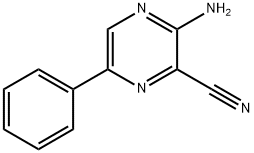Pyrazinecarbonitrile
- CAS NO.:19847-12-2
- Empirical Formula: C5H3N3
- Molecular Weight: 105.1
- MDL number: MFCD00049361
- EINECS: 243-369-5
- SAFETY DATA SHEET (SDS)
- Update Date: 2024-12-18 14:07:02

What is Pyrazinecarbonitrile?
Chemical properties
Colorless liquid
The Uses of Pyrazinecarbonitrile
Pyrazinenitrile (Pyrazinamide EP Impurity) is used as a single-source precursor in the synthesis of metal-free nitrogen-doped carbon nanoparticles (NCNPs). Also, it is an important intermediate in the production of pyrazinamide as an effective anti-tubercular drug.
Definition
ChEBI: Cyanopyrazine is a member of pyrazines and a nitrile.
Synthesis
2-cyanopyrazine was prepared from 2-methylpyrazine with iron phosphate catalyst by vapor phase catalytic ammoxidation in a fixed-bed reactor.
Properties of Pyrazinecarbonitrile
| Melting point: | 18-20°C |
| Boiling point: | 87 °C/6 mmHg (lit.) |
| Density | 1.174 g/mL at 25 °C (lit.) |
| refractive index | n |
| Flash point: | 206 °F |
| storage temp. | Inert atmosphere,Room Temperature |
| solubility | Acetonitrile (Slightly), Chloroform (Slightly) |
| form | Liquid |
| pka | -1.97±0.10(Predicted) |
| color | Clear colorless to yellow |
| Water Solubility | Slightly soluble in water. |
| BRN | 110008 |
| Exposure limits | NIOSH: IDLH 25 mg/m3 |
| CAS DataBase Reference | 19847-12-2(CAS DataBase Reference) |
| NIST Chemistry Reference | Cyanopyrazine(19847-12-2) |
| EPA Substance Registry System | 2-Cyanopyrazine (19847-12-2) |
Safety information for Pyrazinecarbonitrile
| Signal word | Warning |
| Pictogram(s) |
 Exclamation Mark Irritant GHS07 |
| GHS Hazard Statements |
H315:Skin corrosion/irritation H319:Serious eye damage/eye irritation H335:Specific target organ toxicity, single exposure;Respiratory tract irritation |
| Precautionary Statement Codes |
P261:Avoid breathing dust/fume/gas/mist/vapours/spray. P264:Wash hands thoroughly after handling. P264:Wash skin thouroughly after handling. P271:Use only outdoors or in a well-ventilated area. P280:Wear protective gloves/protective clothing/eye protection/face protection. P302+P352:IF ON SKIN: wash with plenty of soap and water. P305+P351+P338:IF IN EYES: Rinse cautiously with water for several minutes. Remove contact lenses, if present and easy to do. Continuerinsing. |
Computed Descriptors for Pyrazinecarbonitrile
| InChIKey | PMSVVUSIPKHUMT-UHFFFAOYSA-N |
Pyrazinecarbonitrile manufacturer
Dr. Silviu Pharmachem Pvt., Ltd.
1Y
Phone:+91-8390608382
Whatsapp: +91 8390608382
product: 2-Cyanopyrazine 98%
New Products
Tert-butyl bis(2-chloroethyl)carbamate 4-Methylphenylacetic acid N-Boc-D-alaninol N-BOC-D/L-ALANINOL N-octanoyl benzotriazole 3-Morpholino-1-(4-nitrophenyl)-5,6-dihydropyridin- 2(1H)-one Furan-2,5-Dicarboxylic Acid DIETHYL AMINOMALONATE HYDROCHLORIDE 1,1’-CARBONYLDIIMIDAZOLE R-2-BENZYLOXY PROPIONIC ACID 1,1’-CARBONYLDI (1,2-4 TRIAZOLE) N-METHYL INDAZOLE-3-CARBOXYLIC ACID (2-Hydroxyphenyl)acetonitrile 4-Bromopyrazole 5-BROMO-2CYANO PYRIDINE 5,6-Dimethoxyindanone 5-broMo-2-chloro-N-cyclopentylpyriMidin-4-aMine 2-(Cyanocyclohexyl)acetic acid 4-methoxy-3,5-dinitropyridine 1-(4-(aminomethyl)benzyl)urea hydrochloride 2-aminopropyl benzoate hydrochloride diethyl 2-(2-((tertbutoxycarbonyl)amino) ethyl)malonate tert-butyl 4- (ureidomethyl)benzylcarbamate Ethyl-2-chloro((4-methoxyphenyl)hydrazono)acetateRelated products of tetrahydrofuran








You may like
-
 2-Cyanopyrazine 98%View Details
2-Cyanopyrazine 98%View Details
19847-12-2 -
 Cyanopyrazine CAS 19847-12-2View Details
Cyanopyrazine CAS 19847-12-2View Details
19847-12-2 -
 2-Cyano pyrazine, 99% CAS 19847-12-2View Details
2-Cyano pyrazine, 99% CAS 19847-12-2View Details
19847-12-2 -
 Pyrazinecarbonitrile CAS 19847-12-2View Details
Pyrazinecarbonitrile CAS 19847-12-2View Details
19847-12-2 -
 1975-50-4 98%View Details
1975-50-4 98%View Details
1975-50-4 -
 14714-50-2 (2-Hydroxyphenyl)acetonitrile 98+View Details
14714-50-2 (2-Hydroxyphenyl)acetonitrile 98+View Details
14714-50-2 -
 118753-70-1 98+View Details
118753-70-1 98+View Details
118753-70-1 -
 733039-20-8 5-broMo-2-chloro-N-cyclopentylpyriMidin-4-aMine 98+View Details
733039-20-8 5-broMo-2-chloro-N-cyclopentylpyriMidin-4-aMine 98+View Details
733039-20-8
Statement: All products displayed on this website are only used for non medical purposes such as industrial applications or scientific research, and cannot be used for clinical diagnosis or treatment of humans or animals. They are not medicinal or edible.